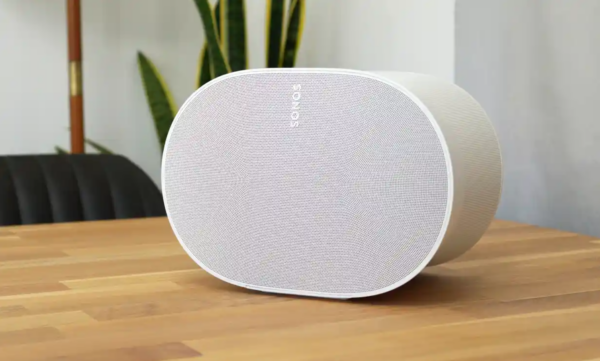The Era 300 is the second in Sonos’ next-generation line of wifi hi-fis, fitting six speakers into a curvy box that can immerse audiences in high-quality sound.
The speaker is priced at £449 ($449/A$749) and rests above the new £249 Era 100, directly competing with Apple’s HomePod and other high-end speakers – premium audio at a premium price.
In contrast to the Era 100, which is a diminutive bookshelf speaker, the Era 300 is an entirely different beast. It must be placed in an open area so that it can project music from its front, sides, and top to fill the room with sound.
If you locate a decent track, a powerful speaker with superb sound demonstrates immersive music.
The Era 300’s compact design enables a series of speakers to project sound all around the observer for complete stereo and spatial audio surround sound.
The speaker connects to your Wi-Fi network and can be commanded via the Sonos app on an Android or iOS device. It also has Bluetooth 5 for connecting other devices and a USB-C port on the rear for bringing in optional Sonos ethernet or line-in adapters for £39 and £19, respectively. It has microphones for use with Sonos’s local voice assistant for controlling playback and Amazon’s Alexa, but not Google’s Assistant.
Specifications
- Dimensions: 16 x 26 x 18.5cm
- Weigh: 4.5kg
- Speakers: four tweeters, two woofers
- Connectivity: wifi 6, Bluetooth 5, USB-C, AirPlay 2, Spotify Connect
Engaging, immersive sound
Feed the Era 300 conventional tracks from Spotify, Bluetooth, or other services, and it will produce exceptional stereo audio with a wide soundstage from a single box. However, it can also play Dolby Atmos tracks from Amazon or Apple Music, producing spatial audio that makes you feel as though you are inside the music rather than sitting in front of it.

Sonos is not the first company to implement spatial or 3D audio, but the Era 300 is the most effective example I’ve heard. It can be a truly transformative experience that complements conventional stereo. Vocals appear to hover in front of you, while background tracks and individual instruments surround you, including above you, and are supported by a powerful bass that flows like waves over you. It has a similar effect to watching a movie with true multi-speaker surround sound but with music and a single speaker.
The Era 300 produces quality sound, but Dolby Atmos music is currently a bit of an untamed west. Even for those services that do support it, the fidelity of the recordings varies greatly. It requires artists to construct the 3D audio experience effectively. Some, including Ed Sheeran and the Weeknd, have done so. Others have completely let the team down by releasing songs that sound significantly worse than their stereo counterparts. If you play one of these, you will be disappointed.
The good news is that the Era 300’s standard stereo sound is also excellent, with detailed highs, forceful mids, and sufficient bass depth for music. The separation between tones, vocal clarity, and balance of this sound are all of the highest quality. As opposed to its competitors, Sonos excels at making each recording gleam without sounding overly processed or clinical. The grunge music is suitably raw, the rap music is pleasant and aggressive, the classical music is exquisitely nuanced, and the electronic music is bursting with high energy.

I doubt many people will need more than one Era 300 in each room, but you can construct a stereo duo, add a Sonos sub for more bass, or use them as rear surround speakers with the latest Beam (gen 2) or Arc soundbars.
Similar to the Era 100, the new speaker supports the “quick tune” Trueplay feature on Android and iOS devices, which adapts the sound to the room. It also supports the time-consuming comprehensive calibration, which takes approximately five minutes and requires an iPhone or iPad, but only needs to be performed once.
Sustainability
Sonos can generally repair the Era 300. The company commits to a minimum of five years of software support for feature updates after it ceases selling a product, but its track record, which includes issue and security corrections for its legacy products, is significantly longer.

The speaker consumes approximately 1.5W when dormant and less while dozing, 9-13W at 50% volume, and a maximum of 38W at maximum volume. It is designed for disassembly for repair, refurbishment, and recycling, and contains forty percent recycled plastic. Sonos offers product recycling and trade-in, and publishes annual responsibility and sustainability reports.
Price
The Sonos Era 300 is available in black and white for £449 ($449/AU$749).
The Ikea Symfonik line begins at £99, the Era 100 costs £249, the Sonos Five costs $549, the Apple HomePod costs $299, the Amazon Echo Studio costs £219.99, and the Google Nest Audio costs £89.99.
Verdict
The Sonos Era 300 is one of the finest available wifi speakers, generating the sort of crisp sound that will have you discovering new facets of familiar songs.
Its stereo performance is outstanding, but it truly comes to life when fed with well-produced Dolby Atmos audio recordings, which fill the room and immerse the listener. Finding quality Dolby Atmos recordings is difficult, as only Amazon and Apple Music offer the technology, and there are numerous subpar arrangements on them.
For the speaker to sound its finest, it requires space around and above it, such as a clear table top or stand, and cannot be placed on a rack. Aside from that, it is simple to use and configure, supports virtually every music service under the sun, and will be perpetually updated for years. It supports a variety of voice assistants, including Sonos’ own, and can be integrated and expanded with any of the company’s multiroom speakers.
However, it is not as simple to recommend as the Era 100. The Era 300 is a superb, future-proof speaker, but it is pricey, and spatial audio is still in its infancy, with Spotify and most other services lacking support – those who are not already subscribed to the appropriate service may want to wait.

Pros:
Fantastic stereo and spatial audio, attractive, simple to set up, broad support for music services, long support life, wifi 6, Bluetooth and line-in options, can be paired, excellent optional voice control, Alexa support, and recycled materials.
Cons:
Expensive, lacks Google Assistant support, cannot be set in a cabinet or shelf, and spatial audio tracks are still inconsistent with limited services.

